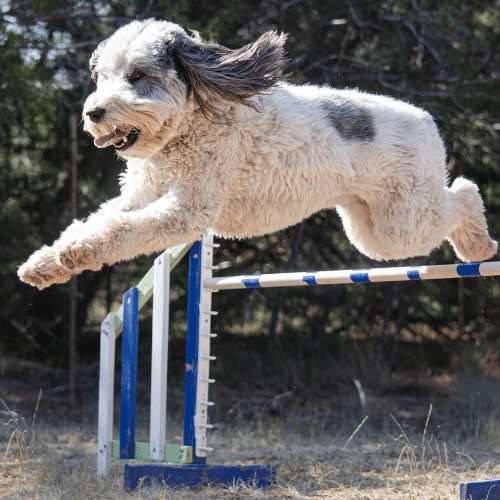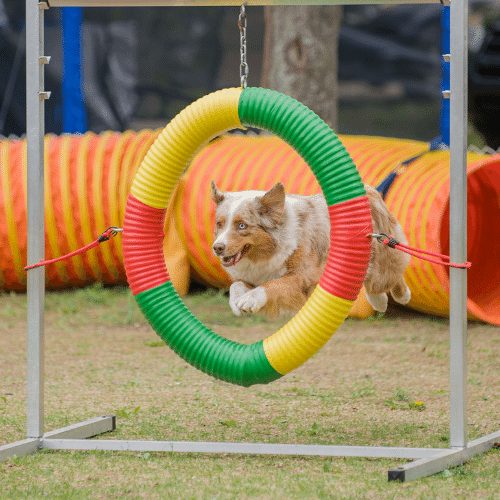Dog Agility Jumping
March 24, 2021 2021-03-24 6:33Jumps are the most prevalent obstacle on any agility course. While a regular course contains one set of weave poles, one A-frame, one dogwalk, one pause table etc. … it will contain at least 10 jumps, some of which your dog takes several times!
Throughout his career, an agility dog is likely to jump tens of thousands of times. It is important that jumping is taught safely, so that dogs do not get injured and can enjoy agility and jumping for a long time to come.
Table of Contents

How high do dogs jump in agility?
The most common question of dog owners starting out in agility is how high their dog will be jumping. The quick answer is: roughly as high as their shoulder height.
The longer answer is that this depends on the organization that you choose to compete in. Different organizations have different height requirements for the jumps. Dogs are grouped by their so-called “height at the withers” and assigned a jump height accordingly.
Because different venues group the dogs differently, the same dog could be required to jump different heights at different trials.
An exception is made for brachycephalic dog breeds. Due to these dogs’ reduced ability to breathe quickly and take in enough oxygen, they usually have to jump 2-4 inches lower than their long-snouted peers. If you own a brachycephalic breed, you should take extra care to not push your dog too hard during agility training. Start with short sessions and low jumps and only increase the duration and jump height if your dog is fit and has stamina.
Once agility dogs reach about 8-10 years of age, most handlers drop their jump height as well. These dogs will jump 2-4 inches lower than younger dogs. Adjusting the jump height like this allows dogs to continue participating in agility events in older years. This keeps them healthy and active while reducing the strain on joints.

Age considerations
Your dog should not start to jump high in agility until he is finished growing. How old exactly this is will depend on his breed.
Small breeds such as Chihuahuas are finished growing by the time they are around 10 months old. Large and giant breeds on the other hand (such as Great Danes) will continue growing until they are over 18 months old.
The reasoning behind this rule is that a dog’s growth plates should be closed by the time he starts jumping high. Growth plates are areas of soft tissue and cartilage at the end of a puppy’s bones. They “fill in” as the puppy is growing.
If a growth plate is injured, it can stunt or stop the growth, leading to severe limping throughout the dog’s life. No agility jump is important enough to risk this!
If you are unsure when your dog’s growth plates are closed and he is ready to jump higher in agility, consult your veterinarian. They can also take x-rays to confirm that the dog is finished growing.
How do I teach my dog to jump for agility?
It is really important that you take jump training slowly and do not rush the steps. You should never put a jump as high as your dog’s shoulder height from the beginning. Instead, start with small jump heights and work your way up gradually.
Unfortunately, a lot of dogs get injured in agility training due to bad jumping habits. They might take off at the wrong spot, land badly or slip. One single bad jump can end your dog’s agility career forever.
When teaching your dog to navigate agility jumps, always make sure to train on a soft and non-slip surface. You should never have your dog jump on concrete, tile floors, hardwood floors or linoleum. Once more – just one unfortunate landing could seriously injure your dog.
Start out with a low jump. You can hold your dog’s collar or harness and throw a treat or toy over the jump. Release your dog to it. There you have your basic jump!
How often should I train?
In the beginning, less is more! You do not want to over-train your dog. On the one hand, he could get very tired and sore from repetitive jumping. On the other hand, his mind can also get “burned out”, especially in breeds that are not traditional agility dogs.
A Border Collie or Australian Shepherd is much more likely to want to train a lot than a Pug or Basset Hound.
You should aim for training jumping no more than 5 minutes every second day at first. If you notice that your dog suddenly seems less interested in jumping and even refuses to jump, this is a sign to reduce the training frequency. Do not continue to push your dog if he seems tired or sore. Just like humans, when our dogs start a new sport, their body needs to adjust gradually.
How many agility jumps do I need?
You can train a lot of different jumping skills on just one single jump. If you have limited space or are on a budget, start out with one jump and perfect your dog’s skills on that one! If you have a larger area to train agility and do not mind spending some more money upfront, get 5-6 jumps. With these, you can set hundreds of small courses right away and run them even with a beginner dog.

Different types of agility jumps
In agility, not all jumps are the same. In fact, there are seven different kinds of jumps used! While the single jump is the most common, you are likely to encounter the other types of jumps in different agility venues and competitions.
Single Jump
The single jump consists of two uprights and one jump bar. This is the most prevalent jump. You can make this one at home the easiest. Single jumps can have “stanchions” (meaning a simple thin upright holding the bar) or “wings” (a triangular or rectangular upright). In Europe and several North American agility associations, only winged jumps are allowed in competitions. If you are just starting out however, you can absolutely use simple stanchions – they are cheaper to make, as well as easier to store.
Double Jump
The double jump consists of two single jumps close together. The challenge is for the dog to spread out as he is jumping. He has to take off differently than for a single jump. This is tricky especially for beginner dogs and very fast dogs.
The double jump can either be ascending (meaning that the first bar is lower than the second) or both bars can have the same height. While you can buy specific double jumps, they are easily made at home by simply putting two single jumps together.
Triple Jump
The triple jump consists of – you guessed it – three single jumps put together. Your dog will have to really spread out to clear this jump. Dogs should have some jumping experience before trying to navigate these jumps. In the beginning they are likely to not jump flat and far enough and knock the third bar.
Like with the double jump, you can either purchase specific triple jumps or make your own by putting three single jumps in a row.

Broad Jump
The broad jump is a very low jump. It tests the dog’s ability to jump flat, far and low. Your dog has to take off very different for a broad jump than for a regular high jump. No matter your dog’s size, the broad jump is always just a few inches high. Depending on the jump height your dog has in agility though, how long the broad jump is will vary.
In AKC agility for example, your dog will jump twice as far as his jump height. If he jumps 8 inches high, the broad jump will be 16 inches wide. If he jumps 24 inches high, the broad jump will be 48 inches, and so on.
You should teach your dog the broad jump gradually. Some dogs think the broad jump is actually something they should step on (it looks similar to other agility equipment such as the pause table). A trick is to put a low bar in front of the first board. This will signal to your dog “jump this!”. Over time, you can make the broad jump longer and stop using the helper bar.
Panel Jump
The panel jump is essentially a single jump, just that instead of a simple jump bar panels are used. This gives the panel jump a distinct look. Dogs usually do not require special training to navigate the panel jump as the physical effort is exactly the same as for the single jump. In fact, some dogs that tend to knock bars or even run underneath bars do a lot better with panel jumps than with single jump bars.
Tire
The tire jump is a very difficult obstacle to learn, especially for larger dogs. The dog has to accurately calculate his flight path. Just a small deviation from the perfect path can cause him to collide with the tire.
These days, only break-away tires are used on agility courses. If a dog was to knock such a tire, it would give way instead of tripping the dog.
When starting out to teach the tire jump, many dogs choose to go around the tire instead of through. You can help your dog find the correct entry by using cones or jump wings to put next to the actual tire. This way you block the wrong choice and only leave the correct one. Over time, you can remove the wings or cones.
Tire jumps should only be taken in a straight approach. You should not set up an agility course for your dog in which he approaches the tire at an angle. Especially for a large-breed dog it will be impossible to safely jump through.


Wall jump (Aqueduct)
The wall jum is rarely seen on home agility courses. Reminiscent of the horse aqueduct jump, this is mostly used in large competitions. Like with the tire, it is important that this jump gives way easily if a dog should knock it. Many dogs struggle with navigating this jump as it looks like a panel jump to them from the front and they do not consider that they will have to jump a little further to clear it.
Unless you visit big international competitions, you are unlikely to ever encounter a wall jump. They are also very difficult to make yourself at home.
The Bottom Line
Jumps are the most prevalent obstacle on any agility course. Dogs will jump roughly as high as their shoulder height – the exact height will depend on the agility organization you choose to compete in. The same dog may be required to jump different heights in different venues.
Older and brachycephalic breeds will jump lower than their younger and long-nosed counterparts.
You should not start jump training until your dog has finished growing. This will be a lot earlier for small breeds than for large and giant breeds. Jumps should be introduced very gradually to avoid injuries. Dogs are not born knowing how to jump safely – and a single injury could end your dog’s agility career forever. Take jumping training slowly and always give your dog rest days. Assess his athletic ability and make smart choices when it comes to how high he will jump.
While there are seven different jump types in agility, the vast majority of all jumps are single jumps. You can make your own double and triple jumps by putting several of those together.

